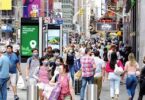Another horrific accident of Pakistan Railway train occurred near Nawab Shah, Sindh perishing more than 30 precious human lives and inflicting serious injuries to several dozens people on Sunday. According to the details,the Hazara Express with over 1000 passengers onboard heading to Pakistan’s Northern city of Havilan struck into a derailment that not only wrecked the train cars but grossly damaged the railway track. Rescue and Relief activities had almost completed, however the train service between Port city of Karachi and Northern parts of the country could not be restored for hours. Federal Minister for Railway Khawaja Saad Rafique told the media that the train was running at the normal speed of 40-45 km while the Railway track was also in good condition. A thorough probe had been ordered to ascertain the events leading to the accident and the government also announced compensation for the deceased and injured passengers to share their grief and support the families of the victims.
Train accidents are fairly common in Pakistan as the aging Railway network has long matured its normal life expectancy. Constructed by the British government in India over 150 years ago, Railway infrastructure, train track, controlling and signaling equipments are completely worn out while insufficiently trained staff coupled with oldaged practices seriously risk the lives of the poor passengers who currently have no other option for a relatively cheaper inter-provinces and inter-cities long journey. Despite multiple plans and several unsuccessful attempts, no successive government could ever implement its agenda for overhauling of Pakistan Railway and provision of the state of the art travel facilities to the people, mainly due to a lack of funds, massive corruption and slackness of the Railway authorities throughout in the past.
Historically, the story of growth and crash and the eventual fate of Pakistan Railway is not much different from rest of the other Pakistani state institutions including the PIA, the Pakistan Steel Mills, National Bank, Pakistan Telecommunication, WAPDA, Oil and Gas Development Corporation (OGDCL), Pakistan National Shipping Corporation and many more. Those institutions excelled during the early years of Pakistan’s Independence and gained appreciation worldwide, later those flourishing institutions fell prey to Politicians’ nepotism, Bureaucratic corruption, malpractices and incompetence of their employees. Meanwhile, the misuse and theft by the public turned those magnificent initiatives into ugly giants who succumbed under the weight of corruption and nonproduction. Currently, Pakistan Railways and many other state institutions have been shaped into white elephants, that are continuously adding to the current account deficit and need bulk of money on a regular basis to continue their routine operations. The majority of the past governments did not put in any serious effort to modernize the Railway system, expansion of the Railway network, and operationalization of Railway’s cargo fleet that is the backbone of the Country’s economy and real engine for revenue generation of Pakistan Railways. On this front, the majority of the political governments resorted to politically motivated initiatives such as renovation of Railways stations, launching of new Railway trains, and opening of new routes on political grounds instead of business strategies.
At the time, the entire setup of the Pakistan Railway was aged and worn out due to exhaustion, corruption, unsatisfactory repair and maintenance, poor management and no provision of funds by the government. The magnificent mass transit and logistic platform has lost its worth and gradually handed over its business to private sector transport and cargo firms. While worsley managed trivial passenger fleet is currently running on major routes and unable to satisfy the travel needs of the poor masses. Presently, there is dire need of a wholehearted national approach to replace the current day shabby Railway infrastructure with modern fleet, induction of state of the art technologies, exclusion of corrupt, incompetent and old aged staff to remobile cargo fleet and reinstate safe, secure and smooth transit facilities to the public. So, this country get rid of recurrent train accidents, mass homicides and poor travel conditions, while moving toward modernization, growth and prosperity.







